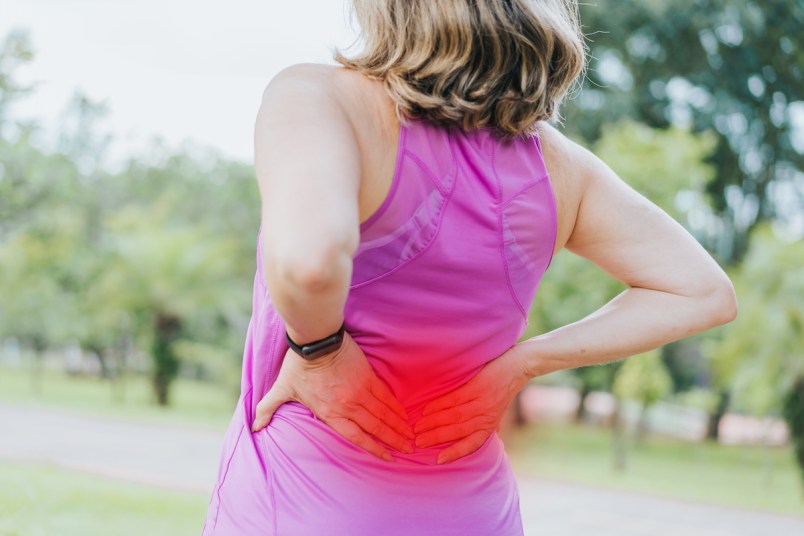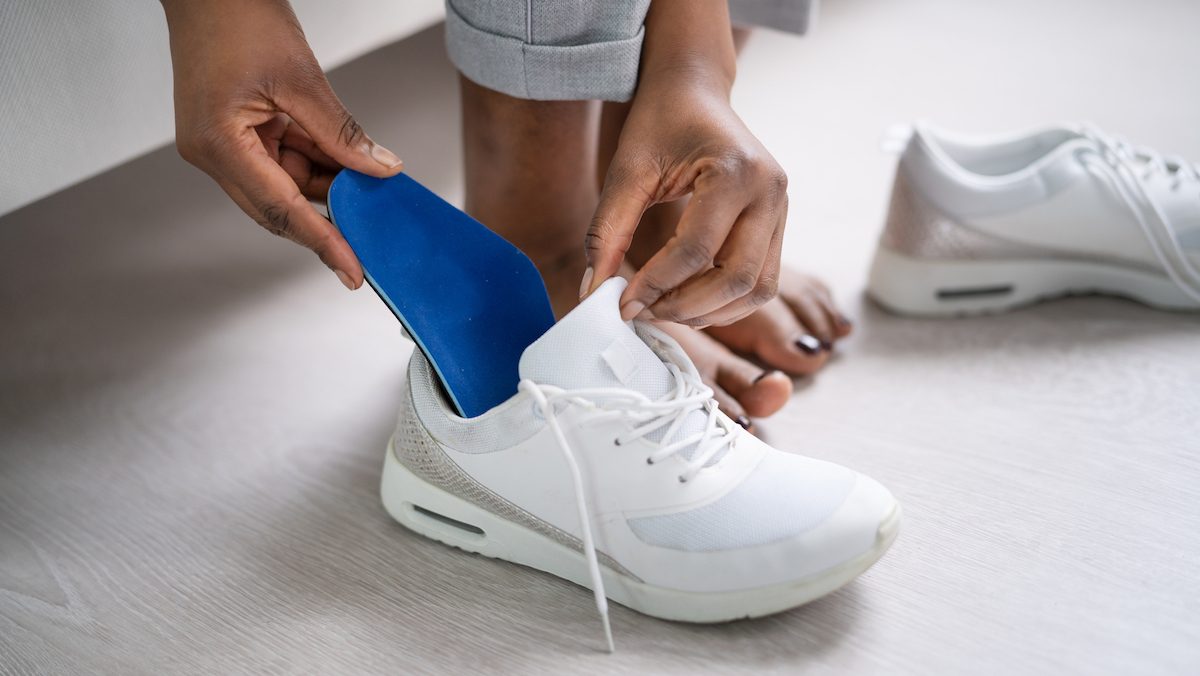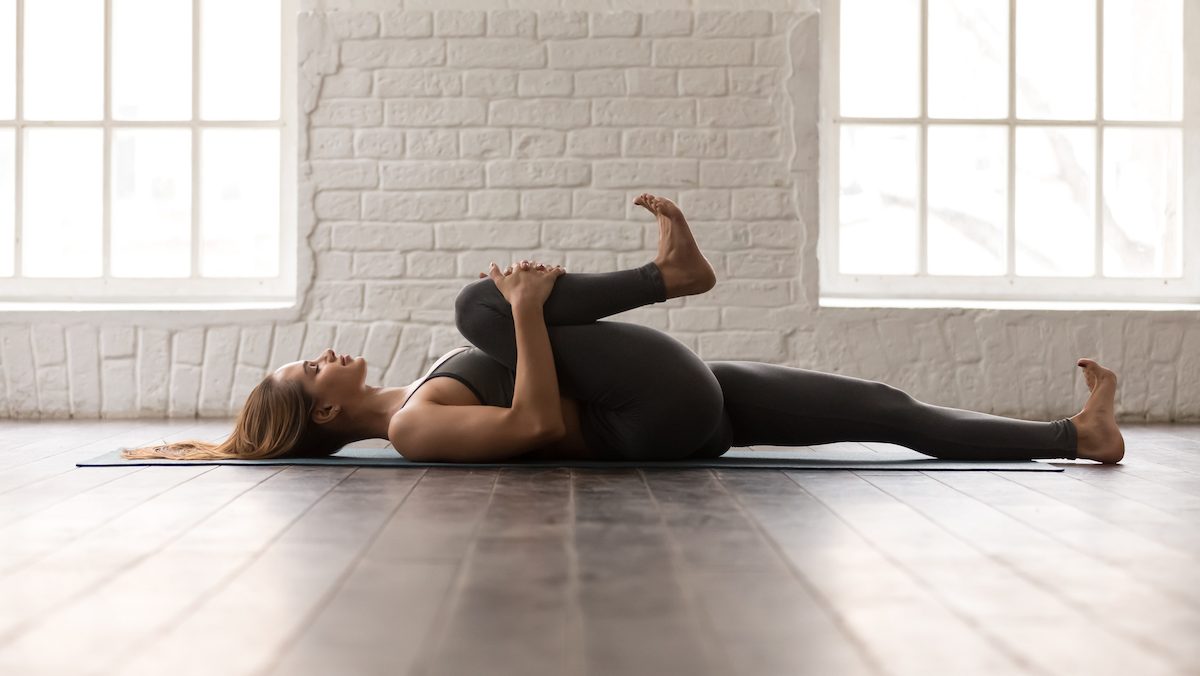Pain Doctors Share Natural Ways to Dodge Lower Back Pain When Walking
Discover the natural remedy one doctor says could be "more effective than morphine for back pain"

Your sneakers are laced up, the dog is excited and your favorite playlist is queued up…you’re ready to head out and start logging your daily steps. But after a while, your lower back begins to ache, making walking nearly impossible. What causes this lower back pain when walking? We asked the experts and they walked us through the causes and symptoms and offered up ways to prevent and treat lower back pain while walking. Read on for their advice.
What causes lower back pain when walking?
Your lower back gives your body support and stability, explains Sean M. Barber, MD, a neurosugeon and spine surgeon at Houston Methodist in Houston, Texas. But sometimes, things go wrong. “Your spine is made up of vertebrae separated by jelly-filled discs, or cushions, that can become inflamed when standing for long periods of time. Your discs may also experience wear and tear with age.”
Indeed, with each birthday, the risk of lower back pain when walking increases, thanks to the natural degeneration of the spine. Research suggests that an estimated 84% of adults will have back pain in their lifetime. “Up to 23% of adults suffer from chronic lower back pain that lasts more than three months, and lower back pain has been said to be the single leading cause of disability worldwide,” adds Dr. Barber.
Often, lower back pain occurs simply because discs, joints, ligaments or muscle in the back can’t tolerate the repetitive motion and weight bearing that walking creates, explains Dr. Barber, who is also a professor of neurosurgery at Weill Cornell Medicine Medical College. “Even though it’s a great form of activity, the repetitive motion of walking places low-grade stress on the irritated part of the spine, leading to inflammation and then a pain response,” he explains. That’s why your back might feel terrific when you leave for a walk, but pain might slowly creep in and intensify the further you walk because your spine has to support your body through each step, eventually causing enough irritation to trigger pain.
Other culprits contributing to lower back pain when walking include:
Back pain trigger: injury
We’ve all heard of someone who “threw their back out” sneezing or bending over to brush their teeth, leaving them with low back pain. What’s more, strains, sprains and injuries resulting from slips and falls, sports or everyday activities can lead to tightness, spasms or stiffness or pain in your lower back when walking.
Back pain trigger: poor body mechanics
Your everyday habits and routine can also increase the odds your lower back will ache when you take a walk. Factors like obesity, poor posture and walking in high heels or shoes without proper support spine, contributing to lower back discomfort. (Click through to discover how to avoid foot pain from standing all day.)
Back pain trigger: lack of movement — or excess movement
If you spend a lot of time seated or live a sedentary lifestyle that can weaken back muscles, leading to lower back pain, says Dr. Barber. But standing or walking for extended periods of time may also aggravate inflammation, resulting in lower back pain when walking. (Click through to learn how to stop foot pain after standing all day.)
Should I see a doctor for lower back pain when walking?
If you experience an occasional twinge of pain or stiffness, you don’t necessarily need to call the doctor. However, Dr. Barber says lower back pain that is severe enough to keep you from normal activities requires a trip to your primary care provider. “Pain that persists longer than 6 weeks, especially if using anti-inflammatory medicine or incorporating rest or activity modification, may require treatment by a specialist.”
Take note, any back pain accompanied by weakness in the legs or changes in bowel or bladder function, requires immediate medical attention because these are signs of a serious condition called cauda equina syndrome, which occurs when the nerves in the lower spine are compressed, cutting off sensation and movement.
How to prevent lower back pain when walking
The best way to ward off back pain when walking is, ironically, taking a walk. In fact, Dr. Barber says being more active can greatly decrease the risk of developing lower back pain. “Maintaining an active lifestyle with regular exercise has been shown to reduce the likelihood of developing lower back pain because it strengthens the muscles in the back, helping your back function properly.”
Read on for more ways to prevent back pain:
Avoid walking in high heels
High heels look great, but they force your feet into an unnatural position that wreaks havoc on your lower back. “Heels can alter the curves of your spine, causing uneven wear and tear on the discs between the vertebrae, as well as the ligaments that attach muscles to your spine,” explains Dr. Barber. Ken Hansraj, MD, chief of spine surgery at New York Spine Surgery & Rehabilitation Medicine in Poughkeepsie, agrees, advising: “Opt for a lower heel and save the stilettos for special occasions.” And when you do want some extra height, experts add that shoes with chunky heels better support the natural spinal curve.
Consider adding shoe inserts

Shoe inserts, or orthotics, treat and ease pain by providing support, properly aligning and stabilizing your feet. A podiatrist can fit you for custom orthotics, or you can buy them over-the-counter, like Dr. Scholl’s Lower Back Pain Relief Orthotics, (Buy on Amazon, $16.28). (Click through for the best insoles for every activity.)
Stretch your back before you head out

Knee-to-chest stretches can strengthen your back to ward off pain. To do: Lie on your back on the floor, using one hand to pull up one knee and press it to your chest. Hold for a few seconds then repeat with the other leg. (Click through to learn how regular stretching reverses your biological age.)
Do a posture check as you stride
Research shows that slouching increases the likelihood you’ll have lower back pain. Instead of drooping your shoulders when standing or walking, keep them as tall as possible, keeping your shoulders back, head up and spine aligned. Finally, when walking, be sure to put your body weight on your heels as you step.
Physical therapist Margaret Martin demonstrates proper walking posture and covers the four principles of correct walking form in this video:
Take movement breaks
Free apps like MyFitnessPal or Caliber let you set reminders to push back from your desk or get off the sofa (ideally, at least once every hour) to prevent prolonged sitting from weakening your back muscles or causing painful inflammation that can lead to lower back pain when walking. (Tip: Click through to see why walking is one of the best ways to keep your blood sugar in check.)
How to ease back pain after walking
While the strategies above will prevent pain, these simple strategies are proven to ease the ache.
Try meditation
“Meditation could be more effective than morphine for someone with back pain,” asserts James Dillard, MD, author of The Chronic Pain Solution. “Research using brain scans seems to show that when someone is able to get into a meditative state, they actually shut down pain pathways in the brain and spinal cord that are hyper-excited. Fewer pain signals get to the brain, reducing discomfort.” And in a study published in JAMA, 61% of people said daily mindfulness meditation reduced problems related to back pain (trouble walking, sleeping or dressing), and 44% were less bothered by the pain they did feel. A guided meditation CD we like: Mindfulness Meditation by Tara Brach, Ph.D., (Buy on Amazon, $5.95).
Rub on a soothing lotion
Applying tiger balm ointment (Walgreens, $5.99) to your lower back increases blood flow to the area, creating warm and cold sensations that decrease the perception of pain. What’s more, the camphor in the over-the-counter painkiller improves circulation to the muscles to ease back aches.
Do the ‘cat’ and ‘cow’ exercises
“I like a simple “cat and cow” stretch to help reduce pain,” says Cindy Geyer, MD, a functional medicine physician at The UltraWellness Center. To do: On a yoga mat or soft ground, get on all fours. Arch your back by dropping your stomach toward the ground and lifting your head backward. Then, hunch over, pulling your stomach upward and tucking your head between your arms. Repeat the sequence up to 20 times.
See Dawn Morse, director of Core Elements Training, demonstrate the stretch here:
For a complete routine, check out physiotherapist Michelle Kenway‘s video guide to a safe stretching routine for the major muscles used in walking including; thighs, buttocks, hips, calves and lower back:
Switch from ice to heat
To lessen lower back soreness after walking, try wrapping a bag of frozen vegetables in a towel and applying it to your back for 10 minutes to reduce muscle soreness and reduce inflammation, say researchers reporting in the Journal of Strength and Conditioning Research. If you’re still in pain after 24 hours, switch to a heating pad, or sock filled with dry beans or rice heated in the microwave. (Click through to learn how ice and heat can also ease sciatica pain.)
Check out even more back pain remedies!
Constipation Is A Sneaky Cause Of Back Pain, Says MD — Simple Home Cures
How To Get Rid of Your ‘Neck Hump’ and Reduce Neck and Back Pain
This 3-Minute Exercise Cured One Woman’s Excruciating Back Pain















